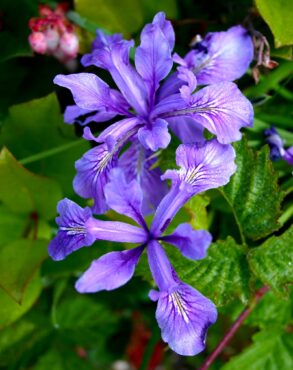
Thou are the iris, fair among the fairest
Who, armed with golden rod
And winged with the celestial azure, bearest
The message of some god…
~ Henry Wadsworth Longfelllow
When mentioning an iris, the most common image conjured up in mind is the pass-along plant commonly called the bearded iris. Many of its cultivars came from the species Iris germanica. Yet, many other iris species and cultivars are fascinating and satisfying to grow.
People easily identify the sword-shaped linear leaves as belonging to the bearded iris. The flowers have three purple falls with brown veins, white bases and yellow beards, and three lavender standards. Most gardeners grow them at some time in their garden. Once they learn how to divide the creeping rhizomes, they pass along divisions to friends and family.
Historically, the iris is one of the oldest cultivated flowers. It’s no surprise that the plant is the subject of numerous books, poems and articles.

The iris was named after the Greek goddess of the rainbow because the plants came in a vast array of colors. The swift goddess glided on rainbows to bring messages to the gods and men. Iris presides not only over the bearded iris; the genus has over 300 species that exclusively grow in the Northern Hemisphere.
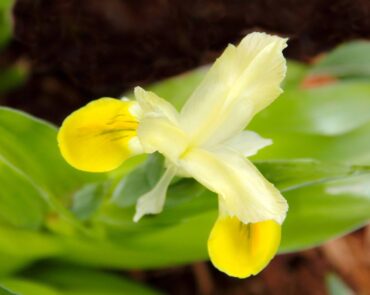
Iris Reticulata
The tiny, bulbous Iris reticulata frequents many gardens and grows alongside the crocus as a winter flower. The deliciously, violet-scented flowers signal that spring will be here soon, and on a warm winter day, you feel like the season arrived.
Even when caught in the snow, the flowers hold up and add some welcome color to the snow-thawed landscape.
Iris reticulats is frequently used in display gardens at the Northwest Flower & Garden Festival in February because it blooms typically at or near the show’s dates.
Divide bulbs when dormant to increase stock, or when flower quality declines.
- Height: 4-6 inches
- Light: Full sun
- Soil: Well-drained, neutral to slightly acidic pH
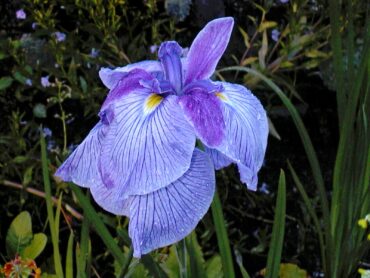
Iris Bucharica
Iris bucharica is one of the few Juno irises successfully grown in the Pacific Northwest. However, it must have adequate drainage and protection from slugs.
The ivory-and-gold, freshly scented flowers sit on top of a fan of foliage with up to seven flowers per stem.
Originally from Afghanistan, Tajikistan and Uzbekistan, it was introduced to England in 1902. The species is classified in the subgenus Scorpiris. It’s uncertain whether the species will remain in the Iris genus, if taxonomists reclassify them.
Most Juno irises grow in desert conditions and thrive with very little water and lots of heat. In the wild, it grows on stony or grassy slopes and makes a fine rock garden specimen in the Pacific Northwest.
Carefully divide clumps every few years and avoid damaging the fleshy roots after the plant has gone dormant.
- Height: 8-16 inches
- Light: Full sun to light shade
- Soil: Neutral pH; fertile, well-drained
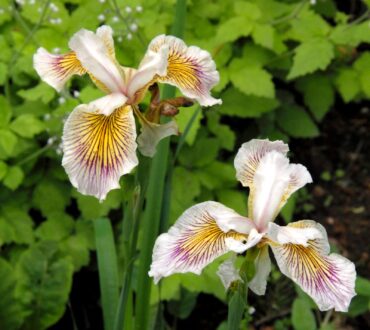
Dutch Iris
The Dutch bulbs, said to originate from Iris xiphium, are excellent as cut flowers. Deer-resistant, they’re a late-spring to early-summer mainstay in the cutting garden.
They grow from true bulbs. Once positioned in the landscape and left undisturbed, they develop clumps that can last a half-century or more. That is some staying power.
This group has many fine cultivars and color combinations. Iris hollandica ‘Eye of the Tiger’ is a unique cultivar, with violet-blue standards, mahogany-bronze falls and yellow blotches, and a height of 18-22 inches. Some bulbs will send up a second flowering stem. Another select one is Iris xiphium ‘Carmen Beauty,’ which reaches a height of 24 inches.
- Height: 18-24 inches
- Light: Full sun to partial shade
- Soil: Humus-rich, well-drained
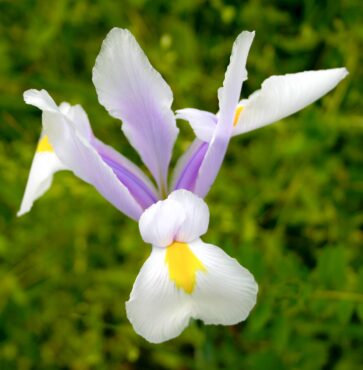
Japanese Iris
Iris ensata, once named Iris kaempferi, is the original Japanese iris. The Japanese consider the plant a symbol of a good omen. They cultivated I. ensata for over 500 years and used it for decoration in ceremonies. Many name cultivars come out of this species, including the variegated Iris ensata ‘Variegata’ with cream-and-green foliage.
Modern hybrids’ color is limited to blue, mauve, purple, violet and white. Sometimes the flowers are stippled or speckled, or have a splash of color in an intricate pattern. Most flowers are round, with overlapping petals, thick falls and short standards.
This iris takes well to container culture if grown in a large pot. Place the pot in a tray of standing water for best results.
- Height: 2-4 feet
- Light: Full sun to partial shade
- Soil: Humus-rich, moist, slightly acidic to neutral
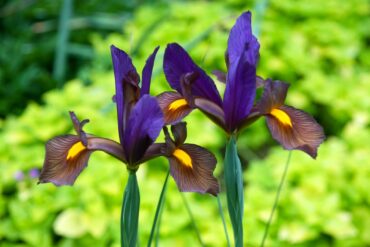
Pacific Coast Native Iris
Closer to home in the Pacific Northwest grows the Pacific Coast Native Iris. Many people affectionately call it PCN or PCI.
This iris is finicky about where it lives in the world. It thrives in Kitsap County with typically long and cool springs, dry summers and mild winters similar to Oregon and California, where most grow. Introduced PCIs also thrive in Britain, Ireland and parts of New Zealand and Australia, wherever the climate is similar to Pacific Northwest’s.
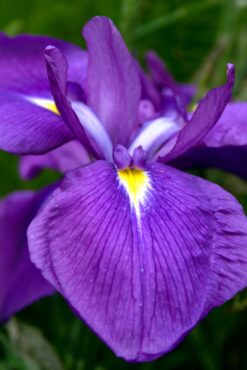
Iris tenax grows natively from Central Washington to southern Oregon and is easiest to grow. The blossoms come in various shades of purple or blue. Other PCIs include I. douglasiana, I. innominata and I. purdyi.
This iris is a bit harder to establish in the garden. The best time to plant them is in the fall. Growers most often ship them in pots or wrap them in peat moss and place them inside a plastic bag. Grow the PCIs in partial shade in a conifer woodland or light dappled shade.
- Height: 10-20 inches
- Light: Full sun to partial shade
- Soil: Humus-rich, moist, slightly acidic to neutral
If you’re tired of growing the bearded iris, try some new species and cultivars in your garden. This list introduces a few to try, and there are many, many more. You’ll fall in love again with iris.






























